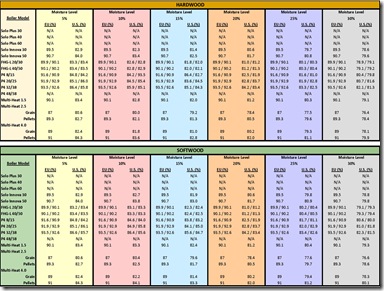European Union to North American Wood Boiler Efficiency Conversion
Background(for the technical savvy):
Thermal Efficiency
For an energy conversion device like a boiler the thermal efficiency is:
So, for a boiler that produces 30KW (100,000 Btu/h) output for each 40KW (140,000 Btu/h) heat-equivalent input, its thermal efficiency (n) is 30/40=0.75, or 75%. This means that 25% of the energy is lost to the environment.
Fuel Heating Values and Efficiency
In Europe the usable energy content of fuel is typically calculated using lower heating value (LHV) of that fuel, i.e. the heat obtained by fuel combustion (oxidation), measured so that the water vapor produced remains gaseous, and is not condensed to liquid water. In North America, the higher heating value (HHV) is used, which includes the latent heat for condensing the water vapor.
Definition of Fuel Heating Values
The lower heating value (LHV) of a fuel is defined as the amount of heat released by combusting a specified quantity (initially at 25 degrees Celsius or another reference state) and returning the temperature of the combustion products to 150 degrees Celsius.
The LHV assumes that the latent heat of vaporization of water in the reaction products is not recovered. It is useful in comparing fuels where condensation of the combustion products is impractical, or heat at a temperature below 150 degrees Celsius cannot be put to use.
By contrast, the higher heating value (HHV) includes the heat of condensation of water in the combustion products but primarily not on the moisture content of the fuel.
Relation Between Higher and Lower Heating Value
The difference between the two heating values depends on the chemical composition of the fuel (dry basis). For example, with hydrocarbons the difference depends on the hydrogen content of the fuel. For gasoline and diesel the higher heating value exceeds the lower heating value by about 10% and 7%, respectively, for natural gas about 11%.
The source of the text above was condensed from: https://en.wikipedia.org/wiki/energy_conversion_efficiency Wikipedia, the free encyclopedia.
Fuel Heating Values for Firewood
Chemically analyzed wood (dry mass) is a “hydrocarbon oxide”, as its major contents are carbon, oxygen and hydrogen with small variations of concentration. Higher concentrations of hydrogen content increases the heating values.
Typical heating values for wood fuel, based on dry mass (w=0%):
Hardwood (EU): LHV (dry) = 18 MJ/Kg (7756 Btu’s/lb) HHV (dry) = 19.3 MJ/Kg (8316 Btu’s/lb)
Coniferous wood (EU): LHV (dry) = 19 MJ/Kg (8187 Btu’s/lb) HHV (dry) = 20.4 MJ/Kg (8790 Btu’s/lb)
Lower heating value LHV can be calculated from higher heating value HHV if hydrogen content of fuel is known, as follows:
LHV (dry mass) = HHV (dry mass) – 0.22 * h
where: LHV, HHV = Heating Values in MJ/Kg, h = Hydrogen content in dry mass in %, 0.22 = Heat of vaporization of combustion products and stoichiometric factors in MJ/Kg
Water Content and Moisture Content in Fuel
Water content “w” is defined as amount of water mass in relation to total mass of fuel, given in %. Water content primarily is used in EU standards.
Moisture content “u” is defined as amount of water mass in relation to dry mass of fuel, given in %. Moisture content primarily is used in US standards.
Influence of water Content to Heating Values
Depending on water content “w” the both heating values are decreasing as follows:
where:
![]() =Higher heating value in MJ/Kg, at water content W in %
=Higher heating value in MJ/Kg, at water content W in %
![]() =Higher heating value in MJ/Kg, in dry mass (water content W = 0%)
=Higher heating value in MJ/Kg, in dry mass (water content W = 0%)
![]() =Water content of fuel (see above) in %
=Water content of fuel (see above) in %
where:
![]() =Lower heating value in MJ/Kg, at water content W in %
=Lower heating value in MJ/Kg, at water content W in %
![]() =Lower heating value in MJ/Kg, in dry mass (water content W = 0%)
=Lower heating value in MJ/Kg, in dry mass (water content W = 0%)
![]() =Water content of fuel (se above) in %
=Water content of fuel (se above) in %
![]() =Heat of vaporization of water in MJ/Kg, based on 25 degrees Celsius
=Heat of vaporization of water in MJ/Kg, based on 25 degrees Celsius
The source of the text above: European testing material standards, especially Austrian standard ÖNorm M 7132
Influence of Heating Values used to Boiler Efficiency
At same heat output Qout the figure Qin in efficiency quotation at top of this document is calculated differently between EU and US standards.
Efficiency calculation in Europe:
Efficiency calculation in the United States:
Ratio between US and European Boiler Efficiency:


what is the best efficiency achievable for a gas fired boiler on HHV basis
This is one of the best most informative articles ive come across in a while.
This is the only article I've been able to find that breaks it down into an equation! Thanks!